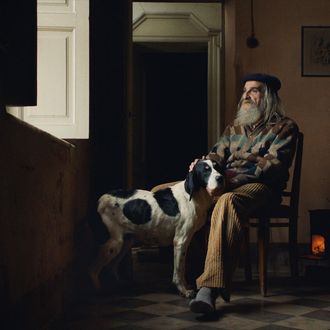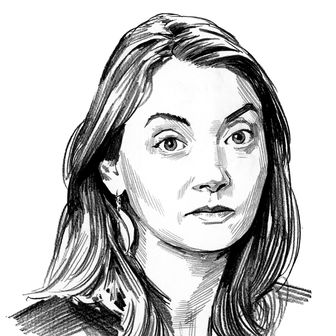
When filmmakers Michael Dweck and Gregory Kershaw first wandered into the Piedmont mountains, they thought they’d fallen into a fairytale kingdom. The tiny, steep towns and foggy woods seemed to them to be a place out of time, an Italian Brigadoon dotted with people following the old ways like pressing their own wine and making their own clothes. Even more beguiling, the pair soon heard about certain men who hunt in those woods for the elusive Alba truffle, secretive foragers who search with their dogs by night, not even telling their families where they go. Dweck and Kershaw’s resulting documentary The Truffle Hunters follows several of the oldest of these men — like Carlo, the impish 88-year-old who sneaks out a window to go truffling, and Aurelio, who is a spry 84. The documentarians track the men and their dogs on their hunts, but they don’t actually try to uncover their mysteries. (I only worked out their names thanks to the press materials.) There’s therefore a lovely reticence in this quiet and beautiful film: It picks its way carefully, like a deer, trying not to disturb the enchantment.
Life is not, of course, a fairytale. Even in the Alpine hills, existence cannot be all lamplit conversations over wine and piles of jewel-bright tomatoes and dogs staring dreamily into their owners’ faces. Cruelty encroaches, as does climate change. The white truffles that Carlo, Sergio (a relative youngster in his ‘60s), and Aurelio are hunting are tremendously valuable. Late in the film, we see a magnificent specimen displayed on a red velvet cushion at some kind of expo or auction — the film never really tells us where we are — which sells for over €100,000. Everyone notes that there are fewer full-grown truffles every year, that the dryer and warmer weather has disrupted their mysterious and un-cultivatable process. Competition is fierce. We hear that rival trufflers are violating long-established territories and laying out poison bait for the dogs. Sergio fits his beloved forager Fiona with a muzzle that will protect her, but he’s concerned about strychnine. If it touches her mouth, she’s lost.
The movie contains three worlds. First, there are the oldest truffle hunters, who seem to have stepped out of time. Then there are the commercial purchasers and connoisseurs, including a natty young truffle broker and a gastronôme buyer — these men spend much of their time on screen inhaling the scent of the truffles, enraptured. The sequences with Sergio and his dogs are different in pace and timbre to the rest: Amid so much meditation, his stuff hits like an action movie interrupting a Tarkovsky. Sergio drives a muddy jeep and plays the drums. You feel he might have a cell phone. Dweck and Kershaw (who also shot the film) rig some of his dogs with head cameras and microphones, so that when we’re out with him, it is as though we, too, are racing, snuffling through the woods, and scrambling over the leaves. Sometimes the movie is about an octogenarian, talking lovingly with his dog, discussing who will take care of her after he goes “beyond the veil.” Sometimes it’s effort and speed and animal senses.
The Truffle Hunters is a documentary, but it’s deliberately non-expository. The mechanics of truffle brokering are left rather shrouded, though there is footage of some wonderful back-alley deals, in which thousands of euros change hands. But are we in one village or four? Are we being told when these conversations are truly spontaneous and candid? Carlo and his wife, Maria, argue across an old oak table about whether he should keep going out onto the hillsides at night, and the argument is as symmetrically and perfectly framed as a Wes Anderson tableau. Can it be quite real? Many scenes seem to have been scrupulously designed and stage managed, but according to the directors, Piedmontese interiors just naturally look this way — by night they’re Caravaggios, by day they’re Vermeers. To meet this painterly atmosphere, shots are composed like illustrations in a storybook. They include no interviews, no talking heads. Instead the camera is a still and patient guest, often looking steadily across a table or across a valley. Many scenes have no dialogue, but listen instead to the complicated sounds of the natural world. We see a snow-covered hillside with a miniature figure trudging across it, or we wait as the ex-forager Angelo pushes wood into a stove, a fireside St. Jerome.
Much of contemporary life has been framed carefully out, but not always by Dweck and Kershaw — many of the people they’re following have deliberately kept certain modernities at bay. Angelo, for instance, is a superb character, a farmer, poet, and ex-acrobat (he boasts of getting 50 marriage proposals in his youth), who sometimes wears a smashing blue beret and rails against the greed that has turned foraging into cutthroat business. The truffle broker Gianfranco begs him to go back into the search, but Angelo is adamant. In a wonderful scene, he smokes and bangs away at a typewriter, trying to get his thoughts down about everything contemporary life has lost. “We have to teach the youth!” he says. “We have to go back 50 years when to undress a woman you had to take ten dresses and four petticoats off. They wore very thick black stockings, but when you arrived at the thighs … you found butter.”
Everything in The Truffle Hunters is about sensation — the stuck typewriter key, the thick black stockings, the dog’s velvet nose in your palm, the shaved truffle quivering on an egg yolk. Any good documentary teaches you how to pay attention to something, which is why this one feels like such an overwhelming experience: It teaches you to pay attention to the world, all of it all at once. The film’s gorgeousness can occasionally get a bit coffee-table bookish, with pages turning to show you yet another plastered room lit by astonishing mountain light. But whenever things turn too lapidary, the image will change to Sergio charging up a sheer hill or Gianfranco trying to winkle another thousand euros out of a chef. These brisker, brusquer moments in the film remind us this isn’t actually a portrait of the past or another world, but the one still with us. We can simply choose it, say Dweck and Kershaw with every shot. We don’t have to let it slip away.


